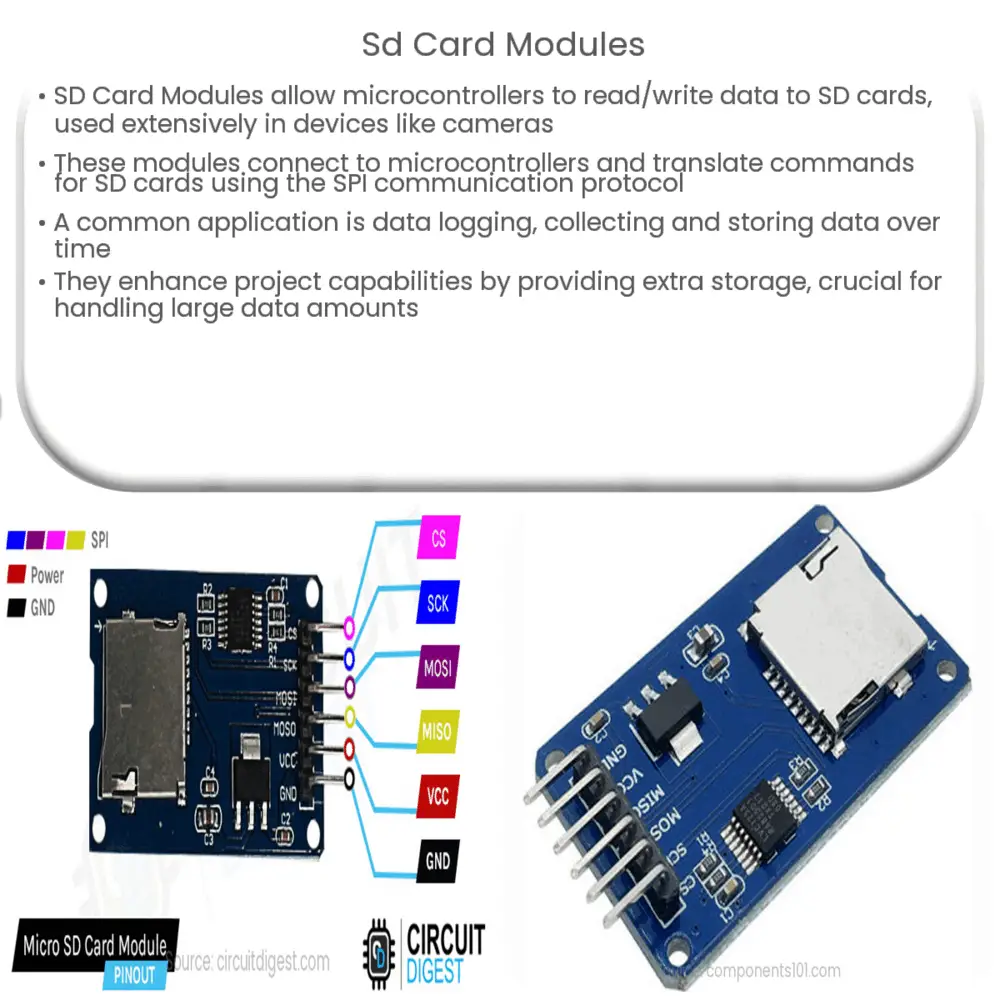Explore the functions, applications, and interfacing of SD Card Modules with microcontrollers. Enhance your DIY electronics projects.

Introduction to SD Card Modules
Secure Digital, often abbreviated as SD, is a non-volatile memory card format that’s used extensively in portable devices such as digital cameras, smartphones, and tablet computers. The SD card standard is maintained by the SD Association. An SD Card Module, on the other hand, is a device that allows microcontrollers, like Arduino or Raspberry Pi, to read and write data to/from SD cards.
Understanding SD Card Modules
An SD Card Module is a circuit board with an SD card slot and a set of pins, which are used to connect the module to a microcontroller. The module acts as an intermediary, translating the commands from the microcontroller into a format that the SD card can understand and vice versa.
How SD Card Modules Work
SD Card Modules primarily operate using the SPI (Serial Peripheral Interface) communication protocol. SPI is a synchronous serial data link that operates in full duplex mode. This means data can be sent and received simultaneously. The SPI bus specifies four logic signals:
- SCLK: Serial Clock (output from master)
- MISO: Master In Slave Out (output from slave)
- MOSI: Master Out Slave In (output from master)
- SS: Slave Select (output from master)
While the first three signals are shared between all devices on the SPI bus, the SS signal is unique for each device. When the master wants to communicate with a slave, it makes the corresponding SS signal low.
Applications of SD Card Modules
One of the most common applications of SD Card Modules is in data logging. With a microcontroller and an SD Card Module, you can collect data from sensors or other input devices, process it as needed, and then store it on an SD card for later analysis. This is particularly useful in situations where data needs to be collected over a long period, such as monitoring temperature or humidity in a greenhouse.
Another important application is to provide additional storage for your microcontroller projects. The flash memory in a microcontroller is often limited, and an SD Card Module can provide gigabytes of extra storage. This is essential if your project involves handling large amounts of data, such as audio or video files.
Choosing the Right SD Card Module
When it comes to choosing an SD Card Module for your projects, there are a few things to consider. First, you need to ensure that the module is compatible with your microcontroller. Most modules work with 3.3V logic levels, but some microcontrollers (like certain Arduino models) operate at 5V. In such cases, you may need a level shifter or a module with built-in level shifting.
Secondly, consider the maximum SD card size that the module supports. The SD standard has evolved over the years, from SD to SDHC (High Capacity), and now to SDXC (Extended Capacity). Make sure your module supports the type and capacity of the SD card you plan to use.
Interfacing SD Card Module with Microcontrollers
The process of interfacing an SD Card Module with a microcontroller is relatively straightforward. After physically connecting the module to the microcontroller using the SPI pins, you will need to write (or find) a library that implements the SPI protocol and the SD card command set. Fortunately, there are many open-source libraries available that can make this process much easier. For example, Arduino provides an SD library that supports both reading and writing on SD cards.
Common Issues and Solutions
While working with SD Card Modules, you may encounter some common issues. One such issue is that the SD card might not be recognized. This could be due to a poor connection, so double-checking your wiring is a good first step. Another common issue is file corruption, which can occur if you remove the SD card while data is being written to it. To avoid this, make sure you ‘close’ any open files in your code before removing the card.
Conclusion
SD Card Modules are a crucial component in many electronics projects, providing a convenient and affordable solution for data logging and additional storage. By understanding how these modules work and how to effectively integrate them with your microcontroller, you can significantly expand the capabilities of your projects. With their ease of use and wide applicability, SD Card Modules continue to be an essential tool in the modern maker’s toolkit.

